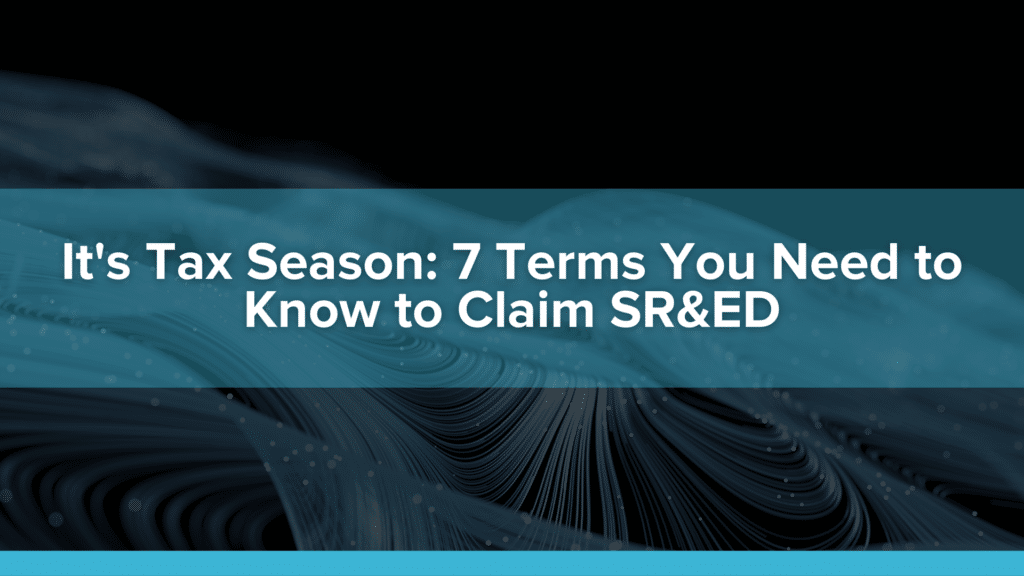For those of you with a December fiscal year end, it’s finally your favourite time of year: tax season! With preparing corporate taxes, also comes preparing your SR&ED tax credit claims.
In the Tax Court of Canada ruling issued Feb 2015, the Honourable Justice Judith Woods wrote, “The scheme of the Act in relation to scientific research expenditures is tortuously complex.” Part of what makes the program so ‘tortuously complex’ are the specific glossary terms that the CRA uses.
Here are the top 7 terms from the CRA Glossary you need to know to claim SR&ED this tax season:
1. Applied Research
“Applied research is work undertaken for the advancement of scientific knowledge with a specific practical application in view.”
In other words, applied research solves a specific problem. If your car is too slow, you’d experiment to answer the questions “Why is it slow?” and “What can I do to make it faster?”
2. Arm’s Length
“Arm’s length refers to a situation where two parties that deal with each other are not related to each other and no control exists between them.”
In other words, this is a transaction in which the buyers and sellers are independent and have no relationship to each other. This ensures that both parties are acting in their own self interest and are not subject to any pressure from the other party.
3. Experimental Development
“Experimental development is work undertaken for the purpose of achieving technological advancement for the purpose of creating new, or improving existing, materials, devices, products or processes, including incremental improvements thereto.”
Qualifying SR&ED projects need to advance technology or fill a technological gap, whether that’s revolutionizing a production process or increasing productivity on a very minor scale.
4. Investment Tax Credit (ITC) Carryback & Carryforward
“Investment tax credit (ITC) carryback refers to an ITC amount the taxpayer earned in a tax year and carried back and applied against Part I tax otherwise payable in any of the 3 previous tax years … Carryforward refers to an ITC amount the taxpayer has not applied, refunded, or carried back that can be carried forward and applied against Part I tax otherwise payable in a subsequent tax year. The carry-forward period is generally 20 tax years.”
In other words, carryback allows you to apply the credit you received up to three years previous and a carryforward allows you to apply the tax credit for up to 20 years credits earned in tax years that end after 1997.
5. Materials Consumed
“Materials consumed in the prosecution of SR&ED basically means the material was destroyed or rendered virtually valueless as a result of the SR&ED.”
This refers to all materials destroyed or rendered during testing, experimentations. For example, this includes trial runs of SR&ED projects and now considered as waste or valueless materials.
6. Materials Transformed
“Materials transformed in the prosecution of SR&ED generally means, material for SR&ED, that has been changed or incorporated into another material or product as a result of the SR&ED and the material still has some value either to the claimant or to another party.”
Basically, this refers to materials that have changed during the experimentation process and still have some value either to the company or to another party.
7. Proxy Method
“The proxy method is an alternative method to the traditional method in computing SR&ED expenditures.”
When the proxy method is applied, you can increase your eligible salary pool by 55% (it was 60% for 2013 fiscal year claims). For example, if you have $100,000 of SR&ED eligible salaries then you get $55,000 to cover your overhead expenses.
The proxy method saves a lot of time internally; you don’t have to document each expense and produce the necessary paperwork to support your calculations. We like to think of the proxy method as an assumed ‘lift’ to cover all associated overhead.
–
If you have any questions about the terms and how they apply to your SR&ED claim, give us a call. The entire CRA glossary for SR&ED can be found at: https://www.cra-arc.gc.ca/txcrdt/sred-rsde/clmng/glssry-eng.html









